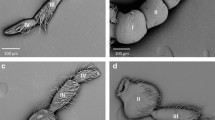Summary
On the antennae of Periplaneta americana, 25 chemo-, hygro- or thermosensitive sensilla were investigated electrophysiologically and, after marking, by transmission and scanning electron microscopy. A clear-cut relationship of functional types to structural types was observed. Two different stimulus conducting structures were observed: a) pore tubules which are found only in smooth, single-walled sensory pegs and b) secretion-filled canals which occur only in grooved double-walled sensilla. Temperature and humidity-sensitive receptors occur only in double-walled sensilla with secretion material as the stimulus conducting system. Olfactory sensory cells were found in both types, however, those with a specific sensitivity for short-chain n-alcohols are restricted to single-walled pegs with pore tubules, while those which are most sensitive to short-chain n-acids and amines are found in double-walled sensilla, sometimes together with thermosensitive units. The stimulus conducting systems may control the access of odorous substances to the dendritic membranes and thus contribute to the discriminatory properties of the sensilla.
Similar content being viewed by others
References
Altner, H., Ernst, K.-D., Kolnberger, I., Loftus, R.: Feinstruktur und adäquater Reiz bei Insekten-sensillen mit Wandporen. Verh. dtsch. zool. Ges. 66, 48–53 (1973)
Altner, H., Thies, G.: Reizleitende Strukturen und Ablauf der Häutung an Sensillen einer euedaphischen Collembolenart. Z. Zellforsch. 129, 196–216 (1972)
Bernard, J.: Etude électrophysiologique de récepteurs impliqués dans l'orientation vers l'hôte et dans l'acte hémophage chez un Hémiptère: Triatoma infestans. Thése, Universitè de Rennes, pp. 1–285 (1974)
Boeckh, J.: Elektrophysiologische Untersuchungen an einzelnen Geruchsrezeptoren auf den Antennen des Totengräbers (Necrophorus Coleoptera). Z. vergl. Physiol. 46, 212–248 (1962)
Boeckh, J.: Die Reaktionen olfaktorischer Neurone im Deutocerebrum von Insekten im Vergleich zu den Antwortmustern der Geruchssinneszellen. J. comp. Physiol. 90, 183–205 (1974)
Davis, E.E.: Identification of antennal chemoreceptors of the mosquito, Aedes aegypti: a correction. Experientia (Basel) 30, 1282 (1974)
Davis, E.E., Sokolove, Ph.G.: Temperature responses of antennal receptors of the mosquito, Aedes aegypti. J. comp. Physiol. 96, 223–236 (1975)
Davis, E.E., Sokolove, Ph.G.: Lactic acid-sensitive receptors on the antennae of the mosquito, Aedes aegypti. J. comp. Physiol. 105, 43–54 (1976)
Dethier, V.G., Schoonhoven, L.M.: Evaluation of evaporation by cold and humidity receptors in caterpillars. J. Insect Physiol. 14, 1049–1054 (1968)
Ernst, K.-D.: Die Feinstruktur von Riechsensillen auf der Antenne des Aaskäfers Necrophorus (Coleoptera). Z. Zellforsch. 94, 72–102 (1969)
Ernst, K.-D.: Die Ontogenie der basiconischen Riechsensillen auf der Antenne von Necrophorus (Coleoptera). Z. Zellforsch. 129, 217–236 (1972)
Hawke, S.D., Farley, R.D.: Antennal chemoreceptors of the desert burrowing cockroach, Arenivaga sp. Tissue and Cell 3, 649–664 (1971a)
Hawke, S.D., Farley, R.D.: The role of pore structures in the selective permeability of antennal sensilla of the desert burrowing cockroach, Arenivaga sp. Tissue and Cell 3, 665–674 (1971b)
Kafka, W.A.: Molekulare Wechselwirkungen bei der Erregung einzelner Riechsensillen. Z. vergl. Physiol. 70, 105–143 (1970)
Kaib, M.: Die Fleisch- und Blumenduftrezeptoren auf der Antenne der Schmeißfliege Calliphora vicina. J. comp. Physiol. 95, 105–121 (1974)
Kaissling, K.-E.: Sensory transduction in insect olfactory receptors. In: Biochemistry of sensory functions (L. Jaenicke ed.), pp. 243–273. Berlin-Heidelberg-New York: Springer 1974
Kellogg, F.E.: Water vapour and carbon dioxide receptors in Aedes aegypti. J. Insect Physiol. 16, 99–108 (1970)
Lacher, V.: Elektrophysiologische Untersuchungen an einzelnen Rezeptoren für Geruch, Kohlendioxyd, Luftfeuchtigkeit und Temperatur auf den Antennen der Arbeitsbiene und der Drohne (Apis mellifica L.). Z. vergl. Physiol. 48, 587–623 (1964)
Loftus, R.: The response of the antennal cold receptor of Periplaneta americana to rapid temperature changes and to steady temperature. Z. vergl. Physiol. 59, 413–455 (1968)
Loftus, R.: Temperature-dependent dry receptor on antenna of Periplaneta. Tonic response. J. comp. Physiol, (in press) (1976)
McIver, S.B.: Fine structure of antennal sensilla coeloconica of culicine mosquitoes. Tissue and Cell 5, 105–112 (1973)
McIver, S.B.: Fine structure of antennal grooved pegs of the mosquito, Aedes aegypti. Cell Tiss. Res. 153, 327–337 (1974)
Meinecke, C.-Ch.: Riechsensillen und Systematik der Lamellicornia (Insecta, Coleoptera). Zoomorphologie 82, 1–42 (1975)
Sass, H.: Zur nervösen Codierung von Geruchsreizen bei Periplaneta americana. J. comp. Physiol. 107, 49–65 (1976a)
Sass, H.: Die Reaktionen von Geruchsrezeptoren auf der Antenne von Periplaneta americana auf Futterdüfte. J. comp. Physiol, (submitted) (1976b)
Slifer, E.H., Prestage, J.J., Beams, H.W.: The chemoreceptors and other sense organs on the antennal flagellum of the grashopper (Orthoptera, Acrididae). J. Morph. 105, 145–191 (1959)
Slifer, E.H., Sekhon, S.S.: Fine structure of the sense organs on the antennal flagellum of the honey bee, Apis mellifera Linnaeus. J. Morph. 109, 351–381 (1961)
Steinbrecht, R.A.: Comparative morphology of olfactory receptors. In: Olfaction and taste (C. Pfaffmann ed.), pp. 3–21. New York: Rockefeller University Press 1969
Steinbrecht, R.A.: Der Feinbau olfaktorischer Sensillen des Seidenspinners (Insecta, Lepidoptera). Z. Zellforsch. 139, 533–565 (1973)
Steinbrecht, R.A., Müller, B.: On the stimulus conducting structures in insect olfactory receptors. Z. Zellforsch. 117, 570–575 (1971)
Waldow, U.: Elektrophysiologische Untersuchungen an Feuchte-, Trocken- und Kälterezeptoren auf der Antenne der Wanderheuschrecke Locusta. Z. vergl. Physiol. 69, 249–283 (1970)
Waldow, U.: Elektrophysiologie eines neuen Aasgeruchsrezeptors und seine Bedeutung für das Verhalten des Totengräbers (Necrophorus). J. comp. Physiol. 83, 415–424 (1973)
Yokohari, F., Tateda, H.: Moist and dry hygroreceptors for relative humidity of the cockroach Periplaneta americana L. J. comp. Physiol. 106, 137–152 (1976)
Yokohari, F., Tominaga, Y., Ando, M., Tateda, H.: An antennal hygroreceptive sensillum of the cockroach. J. Electron Micr. 24, 291–293 (1975)
Author information
Authors and Affiliations
Additional information
Supported by the Deutsehe Forschungsgemeinschaft (Al 56/6)
Rights and permissions
About this article
Cite this article
Altner, H., Sass, H. & Altner, I. Relationship between structure and function of antennal chemo-, hygro-, and thermoreceptive sensilla in Periplaneta americana . Cell Tissue Res. 176, 389–405 (1977). https://doi.org/10.1007/BF00221796
Accepted:
Issue Date:
DOI: https://doi.org/10.1007/BF00221796




